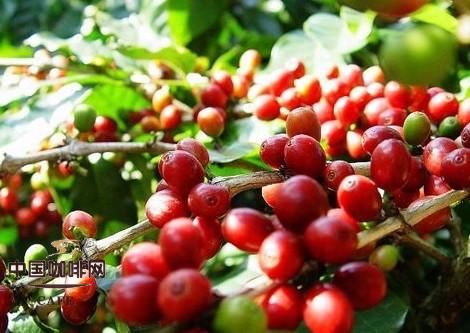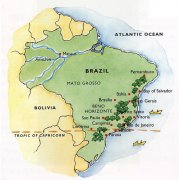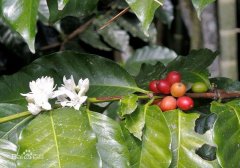Brazilian single coffee large manor with Brazilian coffee production
High-quality coffee beans are refined by water treatment. The coffee beans with less impurities can be obtained by the water washing method, but if the water quality and time are not properly controlled during the fermentation process, the coffee beans will easily be infected with the sour taste of excessive fermentation. and dry beans also need to pay attention to timely re-inspection to prevent coffee beans from being contaminated by wet ground and sundries. Processed beans should be dried in time, and the drying should also have a certain degree. Generally, the moisture content of processed beans is 11% 13%. Insufficient drying can easily make beans moldy, and excessive drying can easily affect the flavor of beans.

Brazil (Brazil) aroma 3 minutes brightness 3.5 minutes mellow 3.5 minutes flavor 4 points aftertaste 4 points
Suitable for baking: the base beans used by City/Full city/Espresso as Espressode should not be baked too deep, because the bean density is low at low altitude, and the pot produces coke bitterness under deep baking, and it is best to start the pot before the second explosion. As for high-grade Brazilian beans, they can have a wide baking range, ranging from city to the middle of the second explosion.
Brazil is the largest coffee producer in the world, and its history can be traced back to the early 17th century. Although the output of Brazilian coffee is the largest in the world, most of them are low-quality Arabica beans and Robusta coffee beans. This is because most of the Brazilian coffee grows in a low altitude, non-volcanic soil, or even a prairie with no forest shade at all. These congenital defects cannot be made up for by new farming techniques, so most people in the boutique coffee world do not have a good impression of Brazilian coffee. However, this does not mean that Brazilian coffee is unbearable. In recent years, Brazilian coffee farmers have worked hard to equate Brazilian coffee with high-quality coffee, and the country's coffee associations have also done their best to help, and their efforts have paid off. the prices auctioned in the coffee market are also quite beautiful. The three main coffee producing areas in Brazil are Bahia, Minas Gerais and Sao Paulo, but most of the best Brazilian beans come from Minas Gerais, and the most famous Hirado is a small producing area in Minas Gerais. As for Santos,
(Santos) is the largest and oldest coffee export port in the bar, and beans marked Santos may come from anywhere in Brazil, so it is not a useful regional or grade indicator. Ordinary Brazilian coffee beans not only have a poor appearance and uneven size, but the important thing is that the taste is very mediocre and undistinctive, and some of them have an unpleasant smell of iodine. Good Brazilian beans come from old coffee trees grown in Bourbon. They smell like stone fruit, taste sweet and low acidity, have the bittersweet taste of chocolate, and some people use the term "extremely smooth and smooth" (Strictly Soft) to describe top Brazilian coffee. Brazil beans have always been an indispensable ingredient in Espresso recipes because they are rich in oil. Good Brazilian beans have mellow, flavor and sweetness, but they do not capture the flavor, providing the best stage for other coffee to enjoy.
Important Notice :
前街咖啡 FrontStreet Coffee has moved to new addredd:
FrontStreet Coffee Address: 315,Donghua East Road,GuangZhou
Tel:020 38364473
- Prev

Nicaragua Fine Coffee Single Coffee Bean
The growing environment of fine coffee beans also has higher requirements. It generally grows at an altitude of 1500 meters or even 2000 meters above sea level, with suitable precipitation, sunshine, temperature and soil conditions. Some world-famous coffee beans also have special geographical conditions, such as the mountain clouds in the Blue Mountains, the free shade provided by afternoon clouds in Kona, and the volcanic ash soil in Antigua.
- Next

Peruvian coffee farm coffee beans grow Peruvian coffee beans
In recent years, coffee producing countries no longer blindly pursue high output while neglecting quality. Many countries have begun to introduce a new coffee evaluation system in order to arouse the enthusiasm of producers and promote the production of fine coffee. For example, Brazil began to implement the Cup of excellence coffee rating system in 1999 in order to better subdivide boutique coffee. And boutique coffee has become
Related
- Does Rose Summer choose Blue, Green or Red? Detailed explanation of Rose Summer Coffee plots and Classification in Panamanian Jade Manor
- What is the difference between the origin, producing area, processing plant, cooperative and manor of coffee beans?
- How fine does the espresso powder fit? how to grind the espresso?
- Sca coffee roasting degree color card coffee roasting degree 8 roasting color values what do you mean?
- The practice of lattes: how to make lattes at home
- Introduction to Indonesian Fine Coffee beans-- Java Coffee producing area of Indonesian Arabica Coffee
- How much will the flavor of light and medium roasted rose summer be expressed? What baking level is rose summer suitable for?
- Introduction to the characteristics of washing, sun-drying or wet-planing coffee commonly used in Mantenin, Indonesia
- Price characteristics of Arabica Coffee Bean Starbucks introduction to Manning Coffee Bean Taste producing area Variety Manor
- What is the authentic Yega flavor? What are the flavor characteristics of the really excellent Yejasuffi coffee beans?

